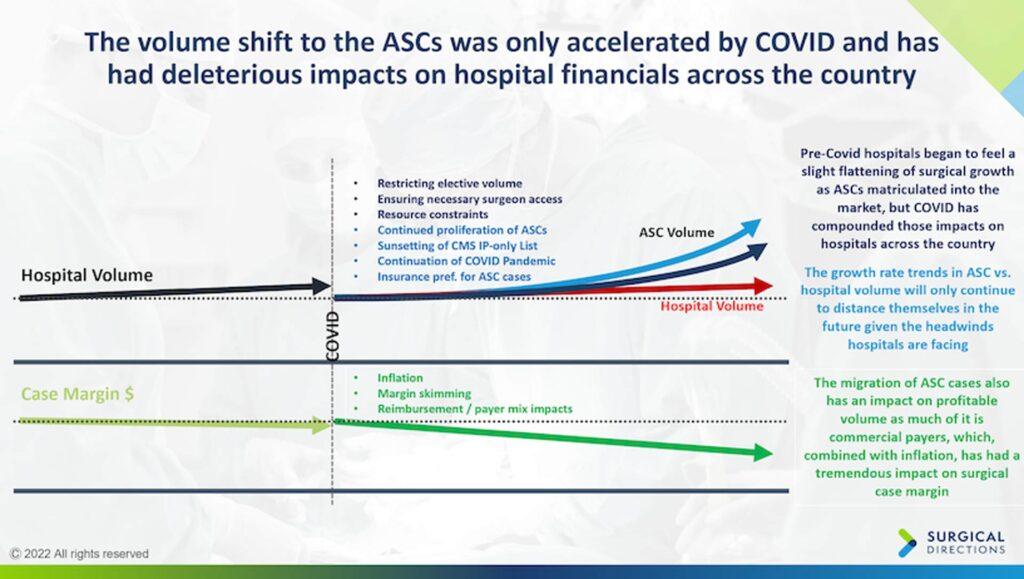CHICAGO, MARCH 27, 2023 / PR NEWSWIRE / Following the surgical volume declines of COVID-19, most hospitals implemented aggressive strategies for rebuilding elective surgery revenue. But, according to Brian Watha, a national expert in surgical access and a consultant with Surgical Directions for more than 10 years, many of these efforts have reduced operating room (OR) profitability, exacerbated staffing problems and strained key surgeon relationships. The solution, he said, is to use advanced data analytics to develop an OR schedule that optimizes utilization while setting the stage for strategic growth.
“Elective surgery has been shifting from hospitals to ambulatory surgery centers for quite some time, but the pandemic accelerated this migration,” said Watha, senior managing director at Surgical Directions. “For hospitals, this exodus of profitable elective volume to ASCs has had a major negative impact on case margins.”

In an effort to recapture elective procedure volume, Watha explained, many hospitals have blocked almost all their available OR time for surgeons who do elective surgery. “As a result, however, these ORs now have almost no time set aside for urgent and emergent cases,” he said.
Watha made these remarks in a recent interview with healthcare editor Robert Fojut. He explained that this approach to block-time allocation conflicts with a powerful trend emerging in the surgical market.
“The migration of lower-acuity elective procedures to the ambulatory setting has dramatically changed the hospital OR case mix,” he said. “OR patients are now generally sicker, and urgent and emergent add-on cases have become a much higher proportion of volume in the typical hospital OR—up to 30 percent or more.”
Without room in the primetime schedule for urgent-emergent volume, these cases are forced into late afternoon and evening hours. According to Watha, this leads to several problems:
- Pushing urgent-emergent volume to the end of the day drives anesthesia coverage costs up because it requires significant overtime pay for CRNAs and can result in additional financial support for the anesthesia practice.
- It exacerbates bed capacity issues. Many hospitals do not have the inpatient staffing to discharge these patients promptly. The result is increasing length of stay.
- It also undercuts long-term revenue strategy because making room for younger, non-blocked surgeons is key to future growth.
According to Watha, the only way to solve these problems is to develop an OR schedule that balances the reality of surgery market trends with hospital resources and surgeons needs.
The starting point, Watha emphasized, is to determine how many OR rooms and procedural sites can be realistically maintained. Hospitals should not just open more rooms without considering the resources needed to support them.
“Adequate OR nursing and anesthesia staffing is only one issue,” he said. “The other staffing concern is making sure there is room on the floor for inpatient cases to avoid length of stay issues.”
Hospital leaders also need to determine how to allocate OR rooms efficiently, Watha explained. One way to achieve this goal is to analyze surgeon scheduling and utilization patterns and identify their impact on block utilization. Block utilization is a proxy for OR utilization, he noted, and if those two metrics are far off, then block allocation is poor.
“Unfortunately, most ORs do not have reliable data on block utilization,” Watha said. “To solve this problem, we have developed a methodology for forecasting surgeon block utilization based on advanced data analytics. This proprietary methodology lets us engage surgeons in constructive conversations about how much OR time they need and what kind of staff support they require.”
This approach allows OR leaders to tailor blocks to each surgeon’s practice. Efficient block allocation not only increases OR utilization significantly, but it also lets the OR create adequate open time for urgent-emergent cases and improve patient throughput.
“The opportunity to reduce length of stay for surgery patients is tremendous,” Watha said. “Based on the hospitals we have worked with, reducing LOS by half a day is a realistic goal. Depending on the size of your organization, that could represent nearly $10 million.”
Data-driven block scheduling also helps create a more “vertical” schedule based on optimal utilization during primetime hours. This helps control nursing costs by reducing the OR’s dependence on travel nurses. It also helps ORs respond to the anesthesia provider shortage by allowing current anesthesia staff to cover rooms more efficiently, which can reduce the need for a financial stipend.
An analytical approach also sets the stage for building effective relationships with surgeons.
“A lot of improving surgeon access is helping to build predictability so we can deliver on surgeon expectations and improve the surgeon experience,” Watha said. “Once you build in predictability, that’s when you can get efficient and ultimately improve your bottom line.”
###
As seen on Seeking Alpha.
Surgical Directions is a healthcare solutions organization that helps clients improve perioperative, procedural care and anesthesia services through consulting, technology, and leadership. We partner with organizations to reduce costs and increase revenue using peer-to-peer leadership and process expertise coupled with actionable data analytics. Our team of experienced practitioners and consultants tackles critical issues while achieving financial, operational, and clinical outcome excellence. Surgical Directions has successfully served 400+ hospitals, ASCs, and medical groups to increase patient access and, most importantly, improve patient care. Additional information is available at www.surgicaldirections.com.



